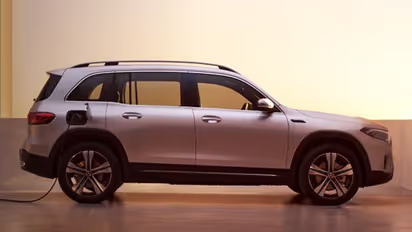Mercedes-Benz EQB introduced in India for Rs 74.50 lakh; Know all about seven-seater electric SUV

Synopsis
EQB is fitted with a lithium-ion battery with a high energy density. It has a maximum voltage of 367 V and a usable energy content of 66.5 kWh. The EQB comes with a third seat row with two additional individual seats. The third row is ideal for families with kids and pet lovers.
The all-electric EQB from Mercedes-Benz has been introduced in India today for an introductory price of Rs 74.5 lakh (ex-showroom). The firm has made it clear that it is prepared to launch electric vehicles. In the past few months, they have debuted three EVs in India: the AMG EQS 54 4MATIC, EQS, and now the EQB.
A high density lithium ion battery pack and an asynchronous motor are found within the seven-seater electric SUV known as the EQB. It has a 66.5 kW battery pack and generates 228 horsepower and 390 nm of torque. It just needs eight seconds to accelerate from 0 to 100 kph. In just 32 minutes, it can go from 10 to 80 percent charged. It can go as fast as 160 kmph. It has a 423-kilometer WLTP range.
Also Read | Mahindra XUV400 EV special edition unveiled; Know the latest additions & specs
The EQB 300 4MATIC has two motors, an asynchronous motor and a newly developed permanently excited synchronous motor in the rear axle. This gives a combined power output of 168 kW and torque of 390 Nm.
A sliding panoramic sunroof, the MBUX control centre, voice controls, wireless smartphone charging, electronic tailgate operation (opening and closing), active brake assist, active lane keep assist, blind spot monitoring, adaptive highbeam assist, TPMS, and knee airbag are all included in the equipment list.
Mercedes-Benz has stated its intention to use only electric vehicles by 2030, therefore the launch of electric items now demonstrates the company's dedication to India and the environment.
Also Read | Hyundai IONIQ 5 EV bookings to begin from December 20, likely to launch at Auto Expo 2023
In 2021, the Mercedes-Benz EQB made its premiere at the Shanghai Auto Show. Mercedes-Benz is the leading luxury automobile manufacturer in India, and because of its confidence in its position, it has chosen to introduce its products in India using an inverted product strategy, bringing in products from the top segment of its product portfolio first and then following it up with products from a segment below
Also Read | 2023 MG Hector facelift look leaked, likely to launch in January next year
Get all the latest Automobile News, including updates on Electric Vehicles, new car and bike launches, reviews, and auto industry trends. Stay informed about mileage comparisons, performance insights, and expert opinions to guide your next vehicle choice. Download the Asianet News Official App for all the latest updates from the world of automobiles.